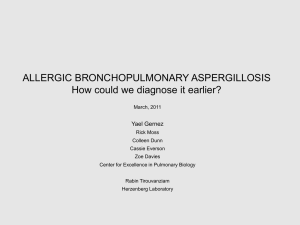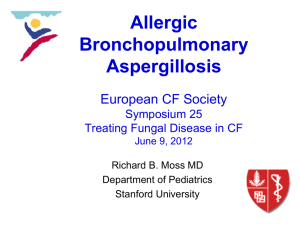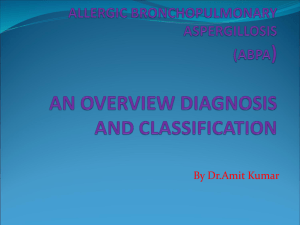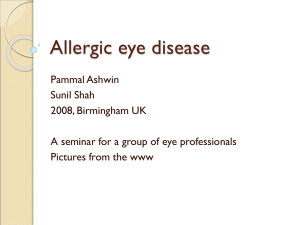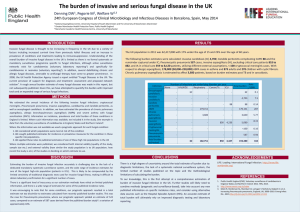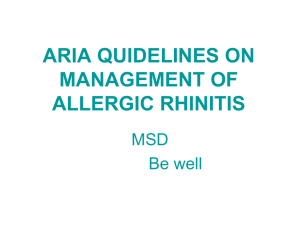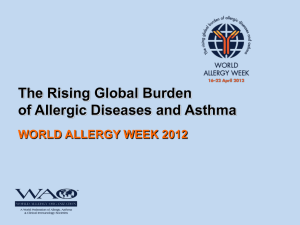Allergic Bronchopulmonary Aspergillosis (ABPA)
advertisement
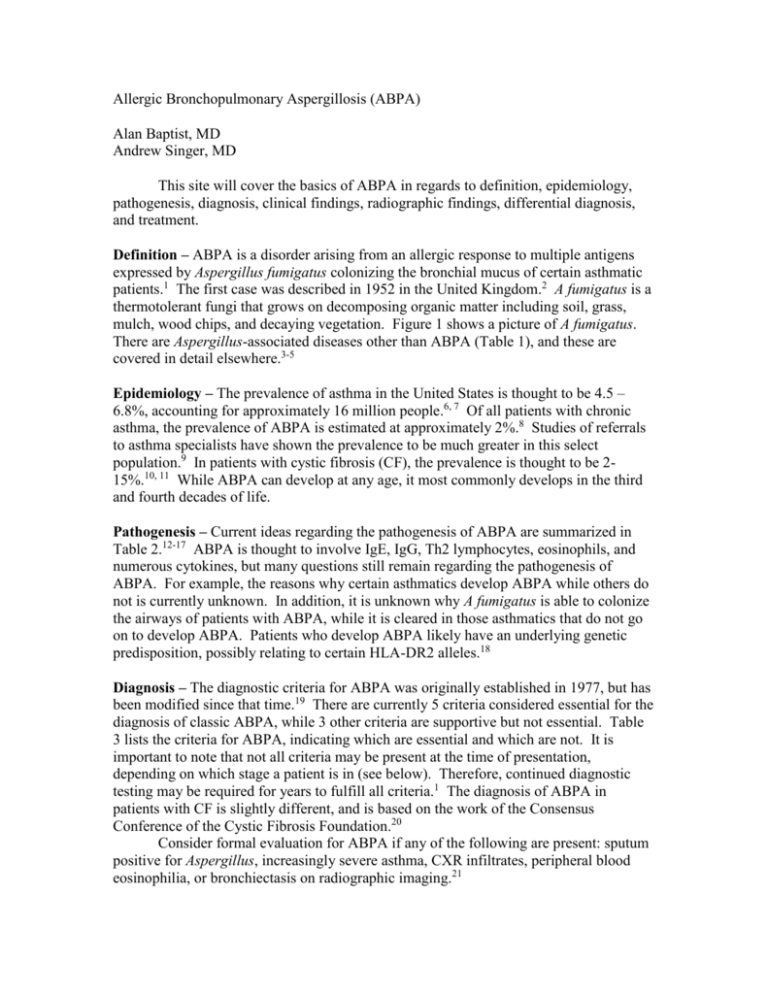
Allergic Bronchopulmonary Aspergillosis (ABPA) Alan Baptist, MD Andrew Singer, MD This site will cover the basics of ABPA in regards to definition, epidemiology, pathogenesis, diagnosis, clinical findings, radiographic findings, differential diagnosis, and treatment. Definition – ABPA is a disorder arising from an allergic response to multiple antigens expressed by Aspergillus fumigatus colonizing the bronchial mucus of certain asthmatic patients.1 The first case was described in 1952 in the United Kingdom.2 A fumigatus is a thermotolerant fungi that grows on decomposing organic matter including soil, grass, mulch, wood chips, and decaying vegetation. Figure 1 shows a picture of A fumigatus. There are Aspergillus-associated diseases other than ABPA (Table 1), and these are covered in detail elsewhere.3-5 Epidemiology – The prevalence of asthma in the United States is thought to be 4.5 – 6.8%, accounting for approximately 16 million people.6, 7 Of all patients with chronic asthma, the prevalence of ABPA is estimated at approximately 2%.8 Studies of referrals to asthma specialists have shown the prevalence to be much greater in this select population.9 In patients with cystic fibrosis (CF), the prevalence is thought to be 215%.10, 11 While ABPA can develop at any age, it most commonly develops in the third and fourth decades of life. Pathogenesis – Current ideas regarding the pathogenesis of ABPA are summarized in Table 2.12-17 ABPA is thought to involve IgE, IgG, Th2 lymphocytes, eosinophils, and numerous cytokines, but many questions still remain regarding the pathogenesis of ABPA. For example, the reasons why certain asthmatics develop ABPA while others do not is currently unknown. In addition, it is unknown why A fumigatus is able to colonize the airways of patients with ABPA, while it is cleared in those asthmatics that do not go on to develop ABPA. Patients who develop ABPA likely have an underlying genetic predisposition, possibly relating to certain HLA-DR2 alleles.18 Diagnosis – The diagnostic criteria for ABPA was originally established in 1977, but has been modified since that time.19 There are currently 5 criteria considered essential for the diagnosis of classic ABPA, while 3 other criteria are supportive but not essential. Table 3 lists the criteria for ABPA, indicating which are essential and which are not. It is important to note that not all criteria may be present at the time of presentation, depending on which stage a patient is in (see below). Therefore, continued diagnostic testing may be required for years to fulfill all criteria.1 The diagnosis of ABPA in patients with CF is slightly different, and is based on the work of the Consensus Conference of the Cystic Fibrosis Foundation.20 Consider formal evaluation for ABPA if any of the following are present: sputum positive for Aspergillus, increasingly severe asthma, CXR infiltrates, peripheral blood eosinophilia, or bronchiectasis on radiographic imaging.21 Clinical Findings – There are no specific clinical or physical examination findings to ABPA. Symptoms can range from recurrent asthma exacerbations with cough, wheeze and shortness of breath to systemic features with fever, anorexia, and malaise.22 Patients will often complain of expectoration of brownish mucous plugs. Asthma is typically present for 5 to 10 years prior to diagnosis,23 and can be of varying severity. Physical exam findings can range from a normal examination to end-stage fibrotic lung disease (clubbing, cor pulmonale, fine crackles). If pulmonary infiltrates are present at the time of examination, lung examination may reveal egophony, crackles or bronchial breath sounds. Lab testing typically done in ABPA include tests that are part of the diagnostic criteria, as listed in Table 3. Additionally, PFTs can be done, and will often reveal airflow obstruction and air trapping, with a reduced FEV1 and increased residual volume. If fibrosis or bronchiectasis has occurred, the PFTs can also show a fibrotic pattern or a reduction in DLCO.24 Radiographic findings – Pulmonary infiltrates will often correlate with clinical symptoms; however in 33% of cases infiltrates are present in asymptomatic patients.23 On CXR, findings are usually seen in the upper and middle lung fields (Figure 2). Findings can be transient (infiltrates, consolidation, mucoid impaction) or permanent (parallel line and ring shadows indicating bronchiectasis, parenchymal fibrosis). Of note, a normal CXR appearance does not exclude the diagnosis of ABPA.25 CT scans in ABPA can show central bronchiectasis, with upper lobe predominance and bronchial wall thickening. While some patients may not have central bronchiectasis (i.e. ABPA-S patients), the presence of bronchiectasis on CT scan warrants further evaluation for ABPA. In addition to changes due to central bronchiectasis, CT scans can show parenchymal infiltrates, bronchial wall thickening, pulmonary fibrosis, or mucoid impaction.26 Figure 3 shows a CT scan of a patient with ABPA. Of note, high resolution CT scans (HRCT) are sometimes necessary to detect radiographic changes due to ABPA that may be missed by conventional CT scans. Stages of ABPA – The natural history of ABPA is difficult to predict.27 A staging system has been developed to try and classify patients for appropriate therapy and to better understand the disease. Table 4 shows the 5 stages of ABPA, as characterized by serum IgE, serum precipitins, blood eosinophilia, CXR findings, and serum IgE-Af/IgGAf. It is important to note that patients do not necessarily progress from stage I through stage V, but may jump from one stage to another and never reach certain stages (such as stage IV or V).28 In addition, as shown in Table 4, the stage a person is in may determine which diagnostic criteria are present (for example, in stage II many criteria may be absent). Differential Diagnosis – Syndromes associated with bronchiectasis or eosinophilia should be considered in the work up of a patient with ABPA. Table 5 is an incomplete list of some of the disease entities on the differential diagnosis for ABPA. Treatment – The goal of treatment in ABPA is to control acute inflammation and limit progressive lung injury (bronchiectasis, fibrosis). The two main targets of ABPA at this time are inflammation (treated with corticosteroids) and fungal colonization (treated with antifungals).1 Corticosteroids – Currently oral steroids are the cornerstone of therapy in ABPA. Steroids are able to suppress inflammation, and this is reflected in a resolution of clinical symptoms, clearance of CXR infiltrates, and a return to stable IgE level.26 Of note, the IgE level in patients with stable ABPA is often elevated above that of patients without ABPA, and the goal of therapy with steroids should not be to try and normalize the IgE level. Usual starting dose is 0.5mg/kg/day for 2 weeks, then 0.5mg/kg QOD for 2 weeks, then taper to off. IgE levels and CXR should be checked 2 months later. Every 2 months (for at least 1 year) an IgE level should be checked to establish a stable baseline level. In addition, PFTs, CXR/CT scan, and clinical symptoms should be monitored as needed.29 If a patient suffers an ABPA flare, they shoud receive another course of corticosteroids. Some patients are very difficult to wean off steroids as they will have a flare of their asthma each time the steroids are stopped (i.e. stage IV patients). In this population, try to wean the steroids down to the lowest alternate day dose tolerated, and every few months consider trying a trial off steroids. Antifungals – Numerous antifungal agents have been tried in ABPA, including nystatin, amphotericin B, natamycin, ketoconazole, and itraconazole.30-32 Of these, amphotericin B and ketoconazole did show efficacy but were limited by toxicity.33 On the other hand, itraconazole has been shown effective in modifying the immunologic activation in ABPA with a low degree of side effects.34 It is currently used in some ABPA patients as adjunctive therapy with steroids. The dose is usually 200mg BID x 4-6 months, then taper over 4-6 months.1 Use of itraconazole as monotherapy has not been studied to date. Other therapies – As with any asthmatic patient, it is important to optimize baseline asthma. Inhaled steroids do not have efficacy in preventing acute episodes of ABPA, but may help to reduce long term oral steroid dosage and are often important in baseline asthma control.35 While the role of environmental exposure has not been well studied in ABPA, areas with high concentrations of mold should be avoided (crawl spaces, decaying organic material, etc). No controlled studies have looked at the use of immunotherapy in ABPA. However, fungal immunotherapy is know to have a high incidence of side effects,36 and until further studies are done immunotherapy should be avoided as treatment for ABPA. References: 1. Vlahakis NE, Aksamit TR. Diagnosis and treatment of allergic bronchopulmonary aspergillosis. Mayo Clin Proc. Sep 2001;76(9):930-938. 2. 3. 4. 5. 6. 7. 8. 9. 10. 11. 12. 13. 14. 15. 16. 17. Hinson KF, Moon AJ, Plummer NS. Broncho-pulmonary aspergillosis; a review and a report of eight new cases. Thorax. Dec 1952;7(4):317-333. Denning DW. Chronic forms of pulmonary aspergillosis. Clin Microbiol Infect. 2001;7 Suppl 2:25-31. deShazo RD, Chapin K, Swain RE. Fungal sinusitis. N Engl J Med. Jul 24 1997;337(4):254-259. Stevens DA, Kan VL, Judson MA, et al. Practice guidelines for diseases caused by Aspergillus. Infectious Diseases Society of America. Clin Infect Dis. Apr 2000;30(4):696-709. Arif AA, Delclos GL, Lee ES, Tortolero SR, Whitehead LW. Prevalence and risk factors of asthma and wheezing among US adults: an analysis of the NHANES III data. Eur Respir J. May 2003;21(5):827-833. Rodriguez MA, Winkleby MA, Ahn D, Sundquist J, Kraemer HC. Identification of population subgroups of children and adolescents with high asthma prevalence: findings from the Third National Health and Nutrition Examination Survey. Arch Pediatr Adolesc Med. Mar 2002;156(3):269-275. Greenberger PA, Patterson R. Allergic bronchopulmonary aspergillosis and the evaluation of the patient with asthma. J Allergy Clin Immunol. Apr 1988;81(4):646-650. Eaton T, Garrett J, Milne D, Frankel A, Wells AU. Allergic bronchopulmonary aspergillosis in the asthma clinic. A prospective evaluation of CT in the diagnostic algorithm. Chest. Jul 2000;118(1):66-72. Mroueh S, Spock A. Allergic bronchopulmonary aspergillosis in patients with cystic fibrosis. Chest. Jan 1994;105(1):32-36. Laufer P, Fink JN, Bruns WT, et al. Allergic bronchopulmonary aspergillosis in cystic fibrosis. J Allergy Clin Immunol. Jan 1984;73(1 Pt 1):44-48. Greenberger PA, Smith LJ, Hsu CC, Roberts M, Liotta JL. Analysis of bronchoalveolar lavage in allergic bronchopulmonary aspergillosis: divergent responses of antigen-specific antibodies and total IgE. J Allergy Clin Immunol. Aug 1988;82(2):164-170. Kurup VP, Kumar A, Kenealy WR, Greenberger PA. Aspergillus ribotoxins react with IgE and IgG antibodies of patients with allergic bronchopulmonary aspergillosis. J Lab Clin Med. May 1994;123(5):749-756. Murali PS, Kumar A, Choi H, Banasal NK, Fink JN, Kurup VP. Aspergillus fumigatus antigen induced eosinophilia in mice is abrogated by anti-IL-5 antibody. J Leukoc Biol. Mar 1993;53(3):264-267. Patterson R, Rosenberg M, Roberts M. Evidence that Aspergillus fumigatus growing in the airway of man can be a potent stimulus of specific and nonspecific IgE formation. Am J Med. Aug 1977;63(2):257-262. Chauhan B, Knutsen A, Hutcheson PS, Slavin RG, Bellone CJ. T cell subsets, epitope mapping, and HLA-restriction in patients with allergic bronchopulmonary aspergillosis. J Clin Invest. May 15 1996;97(10):2324-2331. Tomee JF, Kauffman HF, Klimp AH, de Monchy JG, Koeter GH, Dubois AE. Immunologic significance of a collagen-derived culture filtrate containing proteolytic activity in Aspergillus-related diseases. J Allergy Clin Immunol. Apr 1994;93(4):768-778. 18. 19. 20. 21. 22. 23. 24. 25. 26. 27. 28. 29. 30. 31. 32. 33. Chauhan B, Santiago L, Kirschmann DA, et al. The association of HLA-DR alleles and T cell activation with allergic bronchopulmonary aspergillosis. J Immunol. Oct 15 1997;159(8):4072-4076. Rosenberg M, Patterson R, Mintzer R, Cooper BJ, Roberts M, Harris KE. Clinical and immunologic criteria for the diagnosis of allergic bronchopulmonary aspergillosis. Ann Intern Med. Apr 1977;86(4):405-414. Proceedings of the Cystic Fibrosis Foundation ABPA Consensus Conference; 2001 Jun 12-13; Bethesda, Md. Greenberger PA. Allergic Bronchopulmonary Aspergillosis. In: Adkinson NF YJ, et al., ed. Middleton's Allergy Principles & Practice. Vol 2. Sixth ed: Mosby; 2003:1353-1371. Safirstein BH, D'Souza MF, Simon G, Tai EH, Pepys J. Five-year follow-up of allergic bronchopulmonary aspergillosis. Am Rev Respir Dis. Sep 1973;108(3):450-459. Ricketti AJ, Greenberger PA, Mintzer RA, Patterson R. Allergic bronchopulmonary aspergillosis. Chest. Nov 1984;86(5):773-778. Malo JL, Hawkins R, Pepys J. Studies in chronic allergic bronchopulmonary aspergillosis. 1. Clinical and physiological findings. Thorax. Jun 1977;32(3):254261. Rosenberg M, Mintzer R, Aaronson DW, Patterson R. Allergic bronchopulmonary aspergillosis in three patients with normal chest x-ray films. Chest. Nov 1977;72(5):597-600. Greenberger PA. Allergic bronchopulmonary aspergillosis. J Allergy Clin Immunol. Nov 2002;110(5):685-692. Lee TM, Greenberger PA, Patterson R, Roberts M, Liotta JL. Stage V (fibrotic) allergic bronchopulmonary aspergillosis. A review of 17 cases followed from diagnosis. Arch Intern Med. Feb 1987;147(2):319-323. Patterson R, Greenberger PA, Lee TM, et al. Prolonged evaluation of patients with corticosteroid-dependent asthma stage of allergic bronchopulmonary aspergillosis. J Allergy Clin Immunol. Nov 1987;80(5):663-668. Ricketti AJ, Greenberger PA, Patterson R. Serum IgE as an important aid in management of allergic bronchopulmonary aspergillosis. J Allergy Clin Immunol. Jul 1984;74(1):68-71. Stark JE. Allergic pulmonary aspergillosis successfully treated with inhalations of nystatin. Report of a case. Dis Chest. Jan 1967;51(1):96-99. Currie DC, Lueck C, Milburn HJ, et al. Controlled trial of natamycin in the treatment of allergic bronchopulmonary aspergillosis. Thorax. Jun 1990;45(6):447-450. Leon EE, Craig TJ. Antifungals in the treatment of allergic bronchopulmonary aspergillosis. Ann Allergy Asthma Immunol. Jun 1999;82(6):511-516; quiz 516519. Wark PA, Gibson PG, Wilson AJ. Azoles for allergic bronchopulmonary aspergillosis associated with asthma. Cochrane Database Syst Rev. 2003(3):CD001108. 34. 35. 36. Stevens DA, Schwartz HJ, Lee JY, et al. A randomized trial of itraconazole in allergic bronchopulmonary aspergillosis. N Engl J Med. Mar 16 2000;342(11):756-762. Seaton A, Seaton RA, Wightman AJ. Management of allergic bronchopulmonary aspergillosis without maintenance oral corticosteroids: a fifteen-year follow-up. Qjm. Sep 1994;87(9):529-537. Helbling A, Reimers A. Immunotherapy in fungal allergy. Curr Allergy Asthma Rep. Sep 2003;3(5):447-453.
